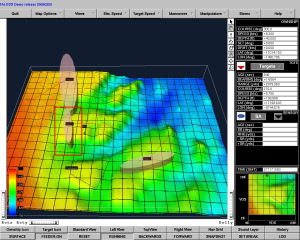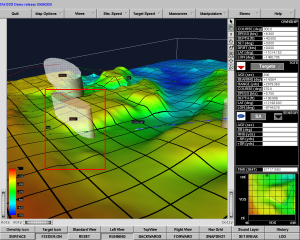TALOSS (Three-dimensional Advanced Localization-Observation Submarine System)
Project Description:
A significant issue in today's Navy is the effectiveness with which naval combat systems can be operationally integrated to yield maximal battlespace awareness for the commanders and crews of all vessels involved. A critical requirement is a common operational/tactical picture. Information superiority can be achieved through a better awareness and understanding of the battlespace. Creating a detailed cognitive picture of the undersea battlespace is vital for the success of the undersea warfare mission. The challenge in achieving "speed of command" is in developing an awareness and understanding of the entire battlespace.
Traditionally and currently, decision makers develop a "mental model" of the battlespace by assimilating data from multiple two-dimensional (2D) displays and paper plots. In situations requiring immediate action, the mental processing required to extend 2D representations to a third dimension uses valuable time and energy. A significant issue in this concept pertains to the effectiveness with which naval combat systems can be operationally integrated to yield maximal battlespace awareness for the commanders and crews of all vessels involved.
 Advances in three
dimensional (3D) presentation tools coupled with the continuing increases
in computer power make the use of 3D visualization techniques to alleviate
the mental information processing issues achievable. Computers today possess
a greater capacity to support the modeling and processing of the types of
complex information that the undersea environment requires. The combination
of 3D visualization software and current/future computational resources provides
the opportunity to generate detailed acoustic and environmental models and
enables the depiction of the undersea domain in a manner that is more natural
and robust than ever before. High-speed computers make it possible to include
discrete simulation models of tactical systems as well as physically realistic
simulation models of other mission critical C&C activities such as underwater
acoustic phenomena related to undersea warfare.
Advances in three
dimensional (3D) presentation tools coupled with the continuing increases
in computer power make the use of 3D visualization techniques to alleviate
the mental information processing issues achievable. Computers today possess
a greater capacity to support the modeling and processing of the types of
complex information that the undersea environment requires. The combination
of 3D visualization software and current/future computational resources provides
the opportunity to generate detailed acoustic and environmental models and
enables the depiction of the undersea domain in a manner that is more natural
and robust than ever before. High-speed computers make it possible to include
discrete simulation models of tactical systems as well as physically realistic
simulation models of other mission critical C&C activities such as underwater
acoustic phenomena related to undersea warfare.
 In fleet systems today,
Target Motion Analysis (TMA) operators view only a depth slice of the ideal
conical angle .Target localization is manually (operator) intensive.
Probabilistic estimators are not generally invoked, as the scenarios do not
often lend themselves to an observable solution. The operator spends valuable
time trying to determine the best solution.
In fleet systems today,
Target Motion Analysis (TMA) operators view only a depth slice of the ideal
conical angle .Target localization is manually (operator) intensive.
Probabilistic estimators are not generally invoked, as the scenarios do not
often lend themselves to an observable solution. The operator spends valuable
time trying to determine the best solution.
TALOSS is a joint project coordinated by NUWC with NRL and Virginia Tech's UVAG group and funded by ONR NAVCIITI Task2.1a. It addresses the problem of visualizing the 3D nature of measurements received from a submarine towed line array and comprises three main areas of research in the context of a submarine ASW mission. The first area of research pertains to the design and development of algorithms that model the undersea environment and ship kinematics. The second area of research focuses on the identification, implementation, and validation of data representation techniques. The last area of research focuses on the development of principles for guiding 3D development for undersea information and on the 'value added' in the use of 3D techniques.
The TALOSS Project has two branches: The first branch involves trying to improve the current system used in the submarines, by designing a 3D visualization that can be effectively used in a monitor screen, with the input devices normally found in the sub (keyboard and trackball). The second branch tries to find which tactical scenarios are best described in a 3D display, like CAVE or I-Desk.